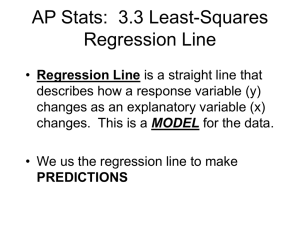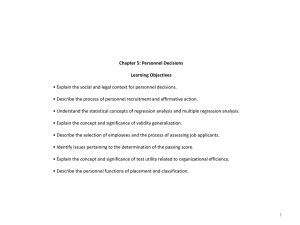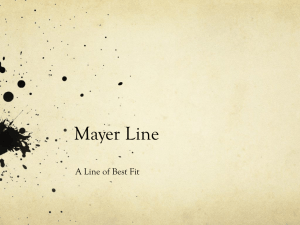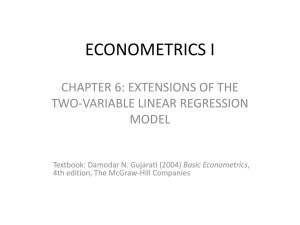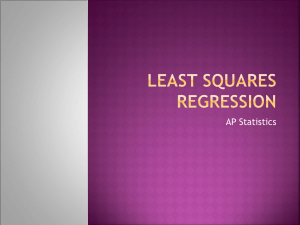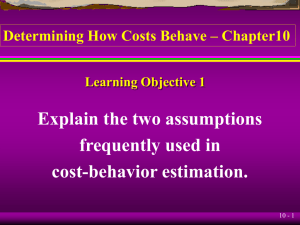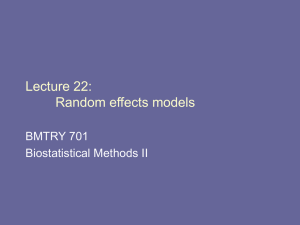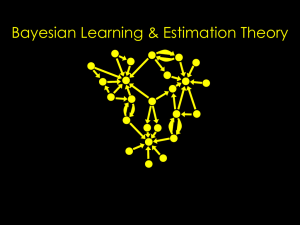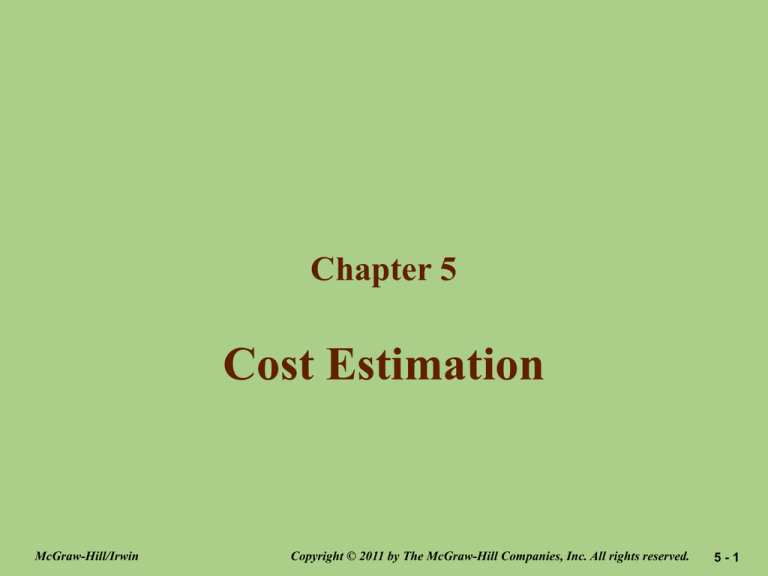
Chapter 5
Cost Estimation
McGraw-Hill/Irwin
Copyright © 2011 by The McGraw-Hill Companies, Inc. All rights reserved.
5-1
Learning Objectives
L.O. 1
L.O. 2
L.O. 3
L.O. 4
L.O. 8
L.O. 5
L.O. 6
L.O. 7
Understand the reasons for estimating fixed and variable costs.
Estimate costs using engineering estimates.
Estimate costs using account analysis.
Estimate costs using statistical analysis.
Use Microsoft Excel to perform a regression analysis
Interpret the results of regression output.
Identify potential problems with regression data.
Evaluate the advantages and disadvantages of alternative
cost estimation methods.
.
5-2
Why Estimate Costs?
• Managers make decisions and need to compare
costs and benefits among alternative actions.
Key question:
• What adds value to the firm?
• Cost estimates can be an important element in
helping managers make decisions.
5-3
Basic Cost Behavior Patterns
L.O. 1 Understand the reasons for estimating fixed and variable costs.
Costs
Fixed costs
Variable costs
Total fixed costs do not
change proportionately
as activity changes.
Total variable costs
change proportionately
as activity changes.
Per unit fixed costs
change inversely as
activity changes.
Per unit variable cost
remain constant as
activity changes.
5-4
LO1
Methods Used to Estimate
Cost Behavior
• Charlene, owner of Charlene’s Computer Care (3C),
wants to estimate the cost of a new computer
repair center.
3 Methods
• Engineering estimates
• Account analysis
• Statistical methods
5-5
Engineering Estimates
L.O. 2 Estimate costs using engineering estimates.
• Cost estimates are based on measuring and
then pricing the work involved in a task.
• Identify the activities involved:
– Labor
– Rent
– Insurance
• Estimate the time and cost for each activity.
5-6
LO2
Engineering Estimates
Advantages:
• Details each step required to perform an operation
• Permits comparison of other centers with similar operations
• Costs for totally new activities can be estimated without
prior activity data.
Disadvantages:
• Can be quite expensive to use
• Based on optimal conditions
5-7
Account Analysis
L.O. 3 Estimate costs using account analysis.
• Establish, track & then review each account
comprising the total cost being analyzed.
• Identify each cost as either fixed or variable.
Fixed
Variable
5-8
Account Analysis
Exhibit 5.1
LO3
John’s cost estimation using account analysis
Factory Overhead at 4,519 Machine Hours
Rent
Utilities
Administration
Supplies
Maintenance
Other
Totals
Total
$ 20,784
$ 15,588
Variable
$ 9,696
$ 7,272
Fixed
$ 11,088
$ 8,316
20,784
10,392
$ 9,696
$ 4,848
$ 11,088
$ 5,544
$ 31,175
$
5,196
$ 103,918
$ 14,543
$ 2,424
$ 48,478
$ 16,632
$ 2,772
$ 55,440
$
$
5-9
Demo problem 1
What is the variable cost per machine hour?
LO3
Account Analysis
Demo 1
Cost estimation using account analysis
Fixed costs + (Variable cost/unit × No. of units) = Total cost
Determine the cost formula.
5 - 11
LO3
Account Analysis
Advantages:
• Managers and accountants are familiar with
company operations and the way costs react
to changes in activity levels.
Disadvantages
• Cost of data collection may surpass benefit.
• Relies heavily on judgment of Managers and
accountants who may be biased.
• Decisions often have major economic consequences
for managers and accountants.
5 - 12
Statistical Cost Estimation
L.O. 4 Estimate costs using statistical analysis.
• Analyze costs within a relevant range, which is
the limits within which a cost estimate may be valid.
• Relevant range for a projection is usually between
the upper and lower limits (bounds) of past activity
levels for which data is available.
5 - 13
LO4
Hi-Low Cost Estimation
Month
1
2
3
4
5
6
7
8
9
10
11
12
Total
Machine
hours
203
319
425
289
388
471
512
443
262
371
494
342
4,519
Overhead
$7,102
8,620
9,120
7,092
7,965
9,641
10,421
8,834
6,935
8,520
10,342
9,326
$103,918
5 - 14
Demo 2
LO4
Hi-Low Cost Estimation
• This is a method to estimate cost based on two cost
observations, the highest and lowest activity level.
Month
Overhead
costs
Repairhours
High
Low
Change
5 - 16
LO4
Hi-Low Cost Estimation
Variable cost per unit (V) =
(Cost at highest activity level – Cost at lowest activity level)
(Highest activity level – Lowest activity level)
Fixed cost (F) =
Total cost at
– (Variable cost × Highest activity level)
highest activity
or
Total cost at
– (Variable cost × Lowest activity level)
lowest activity
5 - 17
LO4
Hi-Low Cost Estimation
Variable cost
=
per RH (V)
=
=
$____
per H
Fixed costs (F) =
=
$
Fixed costs (F) =
=
$
Rounding may produce a slight difference
5 - 18
LO4
Hi-Low Cost Estimation
$10,421- 7,102 $3,319
Variable cost
=
=
=
per RH (V)
512 – 203
309
Fixed costs (F) = $10,421 – [10.74 x512]
Fixed costs (F) =
10.74
$7,102 – [10.74 x203]
=
4,922
= 4,922
Rounding may produce a slight difference
5 - 19
LO4
Hi-Low Cost Estimation
• How do we estimate manufacturing
overhead with 400 hours?
TC = F + VX
400 hours:
$4,922 + (10.74x400)= $9,218
5 - 20
LO4
Regression Analysis
• Regression is a statistical procedure to
determine the relation between variables.
• It helps managers determine how well the
estimated regression equation describes
the relations between costs and activities.
5 - 21
LO4
Regression Analysis
• Hi-low method:
Uses two data points
• Regression:
Uses all of the data points
5 - 22
LO4
Regression Analysis
The Regression Equation:
Y = a + bX
5 - 23
Microsoft as a Tool
L.O. 8 (Appendix A) Use Microsoft Excel
to perform a regression analysis.
• Demo 3 will serve as our Example.
• Interpreting the output is the key to the analysis.
5 - 24
Microsoft as a Tool
♦ The following steps are based Microsoft
Office 2007
• Step 1: Ensure you have the Analysis TookPak installed.
• Step 2: Enter the data for the Dependent and
Independent Variables.
• Step 3: Select Regression from the Data Analysis option.
• Step 4: Select the data to use in the regression.
• Step 5: Run the regression.
Scatter graph
Highlight cells b1 to c13
Do not include months or totals
LO5
Interpreting Regression
• The computer output of scatter graph
gives the following formula:
Total overhead = $4,508 + ($11.025 per MH × No. of MH)
• Estimate 3C’s overhead with 400 repair hours.
TC = F + VX
TC = $6,508 + ($11.02 × 400) = $8,916
5-34
Interpreting Regression
L.O. 5 Interpret the results of regression output.
• Independent variable: Fixed Costs
– Coefficients/Intercept
• Dependent variable: Variable costs
– Coefficients/X Variable 1
5 - 35
LO5
Interpreting Regression
• Correlation coefficient (R):
This measures the linear relationship between
variables. The closer R is to 1.0 the closer the
points are to the regression line. The closer R
is to zero, the poorer the fit of the regression line.
• Coefficient of determination (R2):
This is the square of the correlation coefficient.
Measures the relationship between cost driver and
Changes in the cost pool.
78.8% of the overhead is caused by changes in
Machine hours.
5 - 37
LO5
Interpreting Regression
• T-statistic:
Generally, if it is over 2, then it is considered significant.
If significant, the cost is NOT totally fixed.
95% Confidence:
Gives a range where you can have 95%
confidence that the variable cost coefficient is
between the upper & lower levels.
5 - 39
Practical Implementation Problems
L.O. 6 Identify potential problems with regression data.
• Effect of:
– Nonlinear relations
– Outliers
– Spurious relations
– Using data that do not fit the assumptions
of regression analysis
5 - 41
LO6
Practical Implementation Problems
The Effect of Outliers on the Computed Regression
Computed
regression line
“Outlier”
True regression line
5 - 42
LO6
Practical Implementation Problems
• Problem:
Outliers move the regression line.
• Solution:
Prepare a scattergraph, analyze the graph,
and eliminate highly unusual observations
before running the regression.
5 - 43
Statistical Cost Estimation
L.O. 7 Evaluate the advantages and disadvantages
of alternative cost estimation methods.
Advantages:
• Reliance on historical data is relatively inexpensive.
• Computational tools allow for more data to be used
than for non-statistical methods.
Disadvantages:
• Reliance on historical data may be the only readily
available, cost-effective basis for estimating costs.
• Analysts must be alert to cost-activity changes.
5 - 44
LO7
Effect of Different Methods
on Cost Estimates
• Estimated manufacturing overhead with 400 repair-hours.
5 - 45
LO7
Data Problems
• Missing data
• Outliers
• Allocated and discretionary costs
• Inflation
• Mismatched time periods
5 - 46



